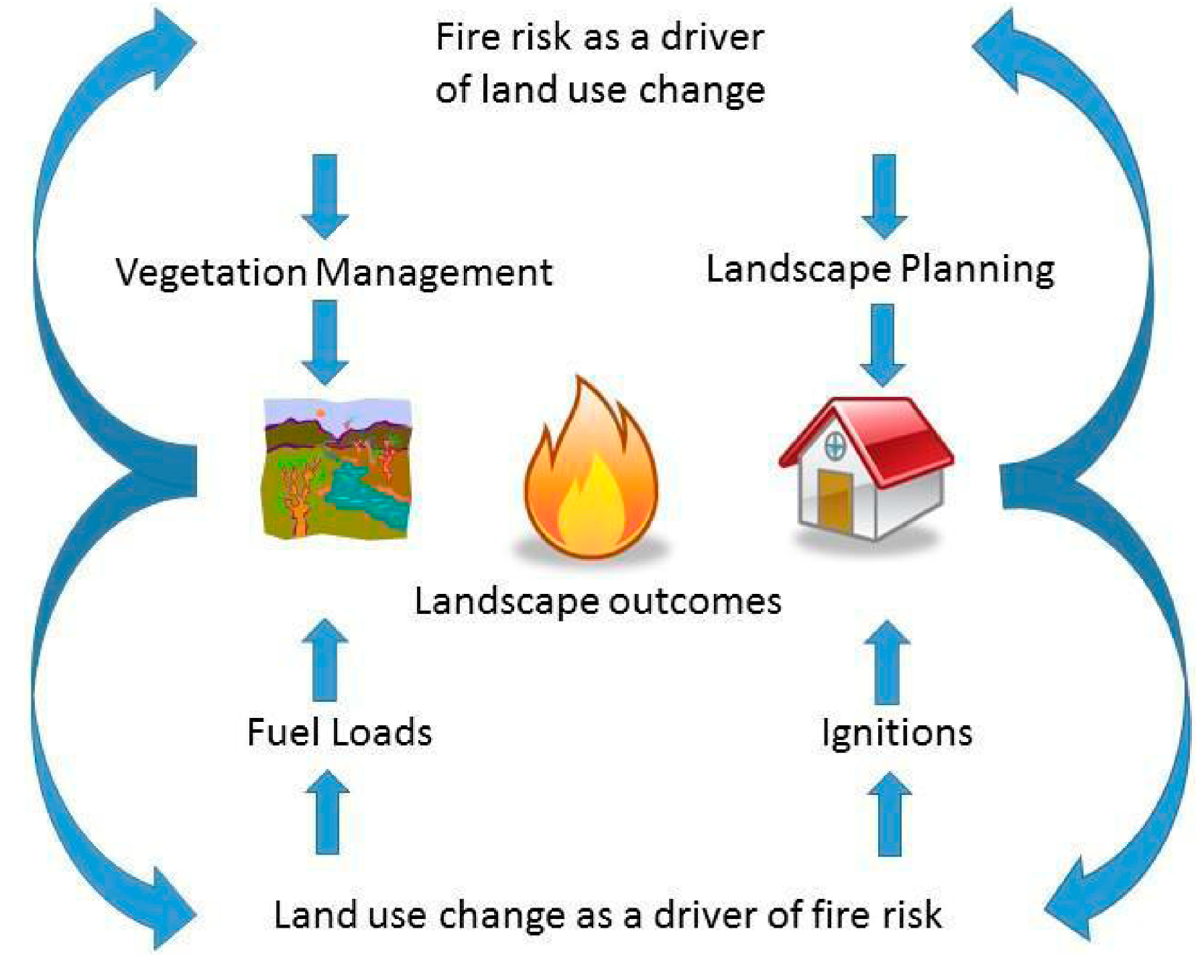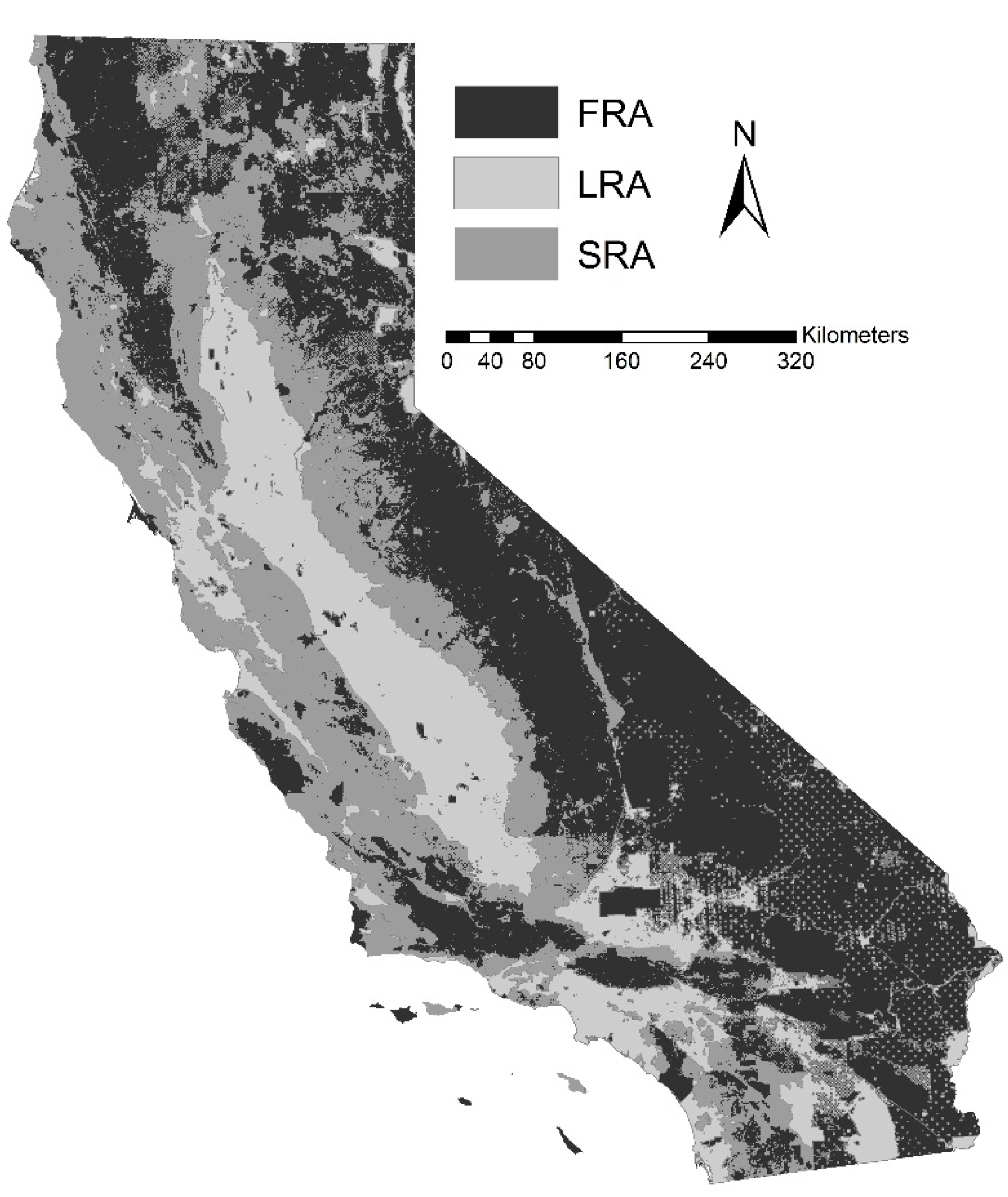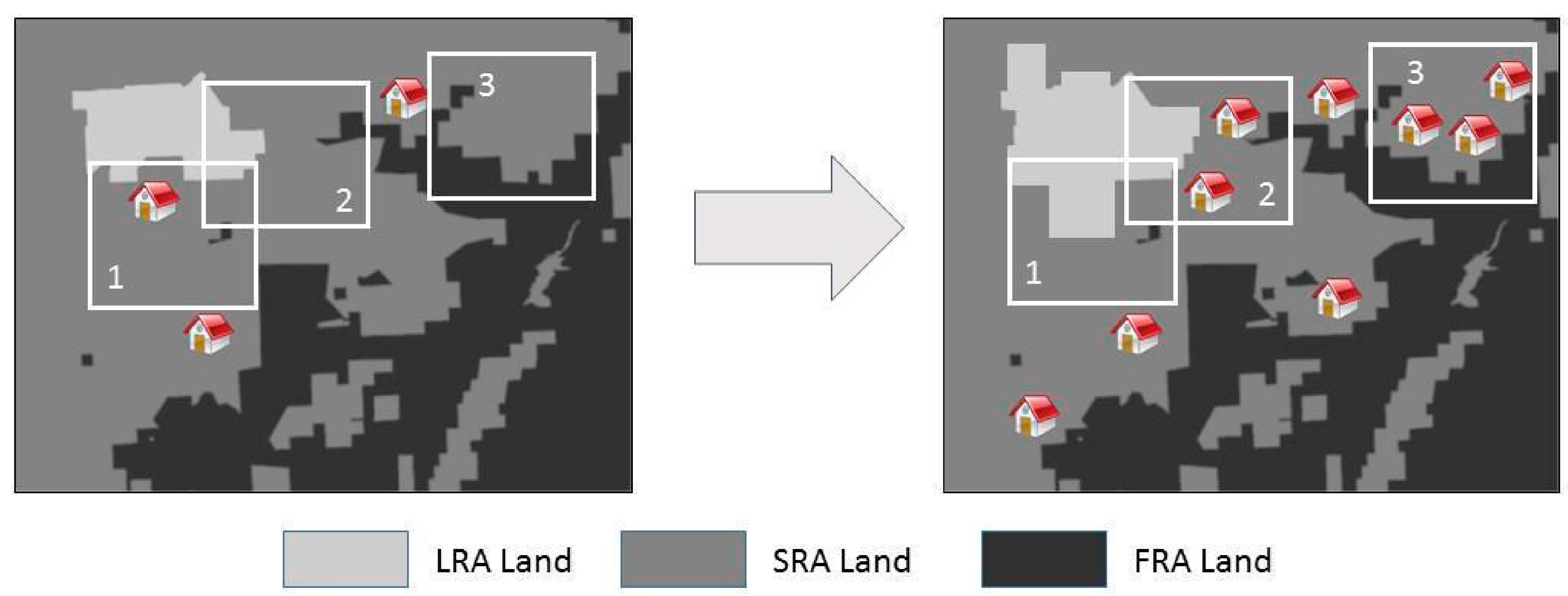Land Use and Wildfire: A Review of Local Interactions and Teleconnections
Abstract
:1. Introduction
2. Fire, Fire Risk, and Fire Management of Risk as Drivers of Land Use Change
2.1. Fire as a Tool for Changing Landscapes
2.2. Fire Risk and the Management of Fire Risk as Drivers of Land Use Change
3. The Impacts of Land Use Change on Drivers of Fire Risk
3.1. Land Use Change and Ignition Frequency
3.2. Land Use Change and Fuel Loads
4. Fire and Land Use Feedbacks and Teleconnections—A Case Study of California Fire Management

4.1. California’s Fire and Land Management System

4.2. Hypothesized Local Feedbacks and Teleconnections

4.2.1. Teleconnection 1: Annexation of SRAs by Municipalities Leads to Potential Changes in Fire Management Statewide
4.2.2. Teleconnection 2: SRA Administration May Encourage Local Low Density Development, Increase Statewide Fire Management Funds but Potentially Costs As Well
4.2.3. Teleconnection 3: Local, State and Federal Land Use and Fire Management Decisions Interact across Administrative Boundaries
5. Future Research Directions and Policy Implications
6. Conclusions
Author Contributions
Conflicts of Interest
References
- Pyne, S.J. Fire: A Brief History; Jeremy Mills Publishing: West Yorkshire, UK, 2001; p. 204. [Google Scholar]
- Pausas, J.G.; Keeley, J.E. A burning story: The role of fire in the history of life. Bioscience 2009, 59, 593–601. [Google Scholar] [CrossRef]
- Karkanas, P.; Shahack-Gross, R.; Ayalon, A.; Bar-Matthews, M.; Barkai, R.; Frumkin, A.; Gopher, A.; Stiner, M.C. Evidence for habitual use of fire at the end of the Lower Paleolithic: Site-formation processes at Qesem Cave, Israel. J. Hum. Evol. 2007, 53, 197–212. [Google Scholar] [CrossRef] [PubMed]
- Bar-Yosef, O. The upper Paleolithic Revolution. Annu. Rev. Anthropol. 2002, 31, 363–393. [Google Scholar] [CrossRef]
- Stephens, S.L.; Martin, R.E.; Clinton, N.E. Prehistoric fire area and emissions from California’s forests, woodlands, shrublands, and grasslands. For. Ecol. Manag. 2007, 251, 205–216. [Google Scholar] [CrossRef]
- Bowman, D.M.J.S.; Balch, J.; Artaxo, P.; Bond, W.J.; Cochrane, M.A.; D’Antonio, C.M.; Defries, R.; Johnston, F.H.; Keeley, J.E.; Krawchuk, M.A.; et al. The human dimension of fire regimes on Earth. J. Biogeogr. 2011, 38, 2223–2236. [Google Scholar] [CrossRef]
- Fry, D.L.; Stephens, S.L.; Collins, B.M.; North, M.P.; Franco-Vizcaíno, E.; Gill, S.J. Contrasting spatial patterns in active-fire and fire-suppressed Mediterranean climate old-growth mixed conifer forests. PLoS One 2014, 9, e88985. [Google Scholar] [CrossRef]
- Collins, B.M.; Everett, R.G.; Stephens, S.L. Impacts of fire exclusion and recent managed fire on forest structure in old growth Sierra Nevada mixed-conifer forests. Ecosphere 2011, 2, 51. [Google Scholar]
- Krawchuk, M.A.; Moritz, M.A. Constraints on global fire activity vary across a resource gradient. Ecology 2011, 92, 121–132. [Google Scholar] [CrossRef]
- Krawchuk, M.A.; Moritz, M.A.; Parisien, M.-A.; van Dorn, J.; Hayhoe, K. Global pyrogeography: The current and future distribution of wildfire. PLoS One 2009. [Google Scholar] [CrossRef]
- Turner, B.L.; Lambin, E.F.; Reenberg, A. The emergence of land change science for global environmental change and sustainability. Proc. Natl. Acad. Sci. 2007, 104, 20666–20671. [Google Scholar] [CrossRef]
- Lambin, E.F.; Meyfroidt, P. Global land use change, economic globalization, and the looming land scarcity. Proc. Natl. Acad. Sci. USA 2011, 108, 3465–3472. [Google Scholar] [CrossRef] [PubMed]
- Golub, A.; Hertel, T.W. Global economic integration and land use change. J. Econ. Integr. 2008, 23, 463–488. [Google Scholar] [CrossRef]
- Lewis, D.J.; Provencher, B.; Butsic, V. The dynamic effects of open-space conservation policies on residential development density. J. Environ. Econ. Manag. 2009, 57, 239–252. [Google Scholar] [CrossRef]
- Irwin, E.G.; Bell, K.P.; Bockstael, N.E.; Newburn, D.A.; Partridge, M.D.; Wu, J. The economics of urban-rural space. Annu. Rev. Resour. Econ. 2009, 1, 435–459. [Google Scholar] [CrossRef]
- Pielke, R.A., Sr. Land use and climate change. Science 2005, 310, 1625–1626. [Google Scholar] [CrossRef] [PubMed]
- Foley, J.A.; DeFries, R.; Asner, G.P.; Barford, C.; Bonan, G.; Carpenter, S.R.; Chapin, F.S.; Coe, M.T.; Daily, G.C.; Gibbs, H.K.; et al. Global consequences of land use. Science 2005, 309, 570–574. [Google Scholar] [CrossRef] [PubMed]
- Seto, K.C.; Reenberg, A.; Boone, C.G.; Fragkias, M.; Haase, D.; Langanke, T.; Marcotullio, P.; Munroe, D.K.; Olah, B.; Simon, D. Urban land teleconnections and sustainability. Proc. Natl. Acad. Sci. USA 2012, 109, 7687–7692. [Google Scholar] [CrossRef] [PubMed]
- Liu, J.; Hull, V.; Batistella, M.; DeFries, R.; Dietz, T.; Fu, F.; Hertel, T.W.; Izaurralde, R.C.; Lambin, E.F.; Li, S.; et al. Framing sustainability in a telecoupled world. Ecol. Soc. 2013, 18, 26. [Google Scholar]
- Moritz, M.A.; Batllori, E.; Bradstock, R.A.; Gill, A.M.; Handmer, J.; Hessburg, P.F.; Leonard, J.; Odion, D.C.; McCaffrey, S.; Schoennagel, T.; et al. Learning to coexist with wildfire. Nature 2014, 515, 58–66. [Google Scholar] [CrossRef] [PubMed]
- McWethy, D.B.; Whitlock, C.; Wilmshurst, J.M.; McGlone, M.S.; Fromont, M.; Li, X.; Dieffenbacher-Krall, A.; Hobbs, W.O.; Fritz, S.C.; Cook, E.R. Rapid landscape transformation in South Island, New Zealand, following initial Polynesian settlement. Proc. Natl. Acad. Sci. USA 2010, 107, 21343–21348. [Google Scholar] [CrossRef] [PubMed]
- Cochrane, M.A. Tropical Fire Ecology; Springer: Berlin, Germany, 2009. [Google Scholar]
- Cochrane, M.A. Fire science for rainforests. Nature 2003, 421, 913–919. [Google Scholar] [CrossRef] [PubMed]
- Mueller, J.; Loomis, J.; González-Cabán, A. Do repeated wildfires change homebuyers’ demand for homes in high-risk areas? A hedonic analysis of the short and long-term effects of repeated wildfires on house prices in Southern California. J. Real Estate Financ. Econ. 2009, 38, 155–172. [Google Scholar] [CrossRef]
- Mueller, J.M.; Loomis, J.B. Does the estimated impact of wildfires vary with the housing price distribution? A quantile regression approach. Land Use Policy 2014, 41, 121–127. [Google Scholar] [CrossRef]
- Hansen, W.D.; Naughton, H.T. The effects of a spruce bark beetle outbreak and wildfires on property values in the wildland-urban interface of south-central Alaska, USA. Ecol. Econ. 2013, 96, 141–154. [Google Scholar] [CrossRef]
- Donovan, G.H.; Champ, P.A.; Butry, D.T. Wildfire risk and housing prices: A case study from Colorado Springs. Land Econ. 2007, 83, 217–233. [Google Scholar] [CrossRef]
- Alexandre, P.; Mockrin, M. Rebuilding and housing development after wildfires. Int. J. Wildfire Res. 2015, in press. [Google Scholar]
- Jacobs, H.M. Who Owns America; University of Wisconsin Press: Madison, WI, USA, 1998; pp. 29–44. [Google Scholar]
- CA Government Code Section 51175–51189; California Government: Sacramento, CA, USA, 1993.
- Troy, A.; Romm, J. Living on the Edge—Economic, Institutional and Management Perspectives on Wildfire Hazard in the Urban Interface (Advances in the Economics of Environmental Resources); Emerald Group Publishing: Bingley, UK, 2007; Volume 6, pp. 101–119. [Google Scholar]
- Stephens, J. Land Use Laws 2012. Available online: http://www.cp-dr.com/node/3272 (accessed on 4 July 2014).
- City of San Diego Brush Managment Regulations; City of San Diego: San Diego, CA, USA, 2013; pp. 1–3.
- Paveglio, T.B.; Prato, T.; Hardy, M. Simulating effects of land use policies on extent of the wildland urban interface and wildfire risk in Flathead County, Montana. J. Environ. Manag. 2013, 130, 20–31. [Google Scholar] [CrossRef]
- Spyratos, V.; Bourgeron, P.S.; Ghil, M. Development at the wildland-urban interface and the mitigation of forest-fire risk. Proc. Natl. Acad. Sci. USA 2007, 104, 14272–14276. [Google Scholar] [CrossRef] [PubMed]
- Syphard, A.D.; Keeley, J.E.; Massada, A.B.; Brennan, T.J.; Radeloff, V.C. Housing arrangement and location determine the likelihood of housing loss due to wildfire. PLoS One 2012, 7, e33954. [Google Scholar] [CrossRef] [PubMed]
- Wondzell, S.M.; Burnett, K.M.; Kline, J.D.; Wales, B.C.; Suring, L.H.; Hemstrom, M.A. Modeling potential outcomes of fire and fuel management scenarios on the structure of forested habitats in northeast Oregon, USA. Landsc. Urban Plan. 2007, 80, 223–236. [Google Scholar] [CrossRef]
- Keeley, J.E. Fire management impacts on invasive plants in the Western United States. Conserv. Biol. 2006, 20, 375–384. [Google Scholar] [CrossRef]
- Potts, J.B.; Stephens, S.L. Invasive and native plant responses to shrubland fuel reduction: Comparing prescribed fire, mastication, and treatment season. Biol. Conserv. 2009, 142, 1657–1664. [Google Scholar] [CrossRef]
- D’Antonio, C.M.; Vitousek, P.M. Biological invasions by exotic grasses, the grass/fire cycle, and global change. Annu. Rev. Ecol. Syst. 1992, 23, 63–87. [Google Scholar] [CrossRef]
- Burby, R.J. Hurricane Katrina and the paradoxes of government disaster policy: Bringing about wise governmental decisions for hazardous areas. Ann. Am. Acad. Pol. Soc. Sci. 2006, 604, 171–191. [Google Scholar] [CrossRef]
- Calef, M.P.; McGuire, A.D.; Chapin, F.S. Human influences on wildfire in Alaska from 1988 through 2005: An analysis of the spatial patterns of human impacts. Earth Interact. 2008, 12, 1–17. [Google Scholar]
- De Wilde, L.; Chapin, F.S. Human impacts on the fire regime of interior Alaska: Interactions among fuels, ignition sources, and fire suppression. Ecosystems 2007, 9, 1342–1353. [Google Scholar]
- Moreira, F.; Viedma, O.; Arianoutsou, M.; Curt, T.; Koutsias, N.; Rigolot, E.; Barbati, A.; Corona, P.; Vaz, P.; Xanthopoulos, G.; et al. Landscape—Wildfire interactions in southern Europe: Implications for landscape management. J. Environ. Manag. 2011, 92, 2389–2402. [Google Scholar] [CrossRef]
- Sadasivuni, R.; Cooke, W.H.; Bhushan, S. Wildfire risk prediction in southeastern Mississippi using population interaction. Ecol. Modell. 2013, 251, 297–306. [Google Scholar] [CrossRef]
- Dondo Bühler, M.; de Torres Curth, M.; Garibaldi, L.A. Demography and socioeconomic vulnerability influence fire occurrence in Bariloche (Argentina). Landsc. Urban Plan. 2013, 110, 64–73. [Google Scholar] [CrossRef]
- Holz, A.; Veblen, T.T. The amplifying effects of humans on fire regimes in temperate rainforests in western Patagonia. Palaeogeogr. Palaeoclimatol. Palaeoecol. 2011, 311, 82–92. [Google Scholar] [CrossRef]
- Nunes, A.N. Regional variability and driving forces behind forest fires in Portugal—An overview of the last three decades (1980–2009). Appl. Geogr. 2012, 34, 576–586. [Google Scholar] [CrossRef]
- Lein, J.K.; Stump, N.I. Assessing wildfire potential within the wildland-urban interface: A southeastern Ohio example. Appl. Geogr. 2009, 29, 21–34. [Google Scholar] [CrossRef]
- Chas-Amil, M.L.; Touza, J.; García-Martínez, E. Forest fires in the wildland-urban interface: A spatial analysis of forest fragmentation and human impacts. Appl. Geogr. 2013, 43, 127–137. [Google Scholar] [CrossRef]
- Syphard, A.D.; Radeloff, V.C.; Keeley, J.E.; Hawbaker, T.J.; Clayton, M.K.; Stewart, S.I.; Hammer, R.B. Human influence on California fire regimes. Ecol. Appl. 2007, 17, 1388–1402. [Google Scholar] [CrossRef]
- Syphard, A.D.; Radeloff, V.C.; Hawbaker, T.J.; Stewart, S.I. Conservation threats due to human-caused increases in fire frequency in Mediterranean-climate ecosystems. Conserv. Biol. 2009, 23, 758–769. [Google Scholar] [CrossRef]
- Lampin-Maillet, C.; Jappiot, M.; Long, M.; Morge, D.; Ferrier, J.-P. Characterization and mapping of dwelling types for forest fire prevention. Comput. Environ. Urban Syst. 2009, 33, 224–232. [Google Scholar] [CrossRef]
- Lampin-Maillet, C.; Long-Fournel, M.; Ganteaume, A.; Jappiot, M.; Ferrier, J.P. Land cover analysis in wildland-urban interfaces according to wildfire risk: A case study in the South of France. For. Ecol. Manag. 2011, 261, 2200–2213. [Google Scholar] [CrossRef]
- Ruiz-Mirazo, J.; Martínez-Fernández, J.; Vega-García, C. Pastoral wildfires in the Mediterranean: Understanding their linkages to land cover patterns in managed landscapes. J. Environ. Manage 2012, 98, 43–50. [Google Scholar] [CrossRef]
- Carmo, M.; Moreira, F.; Casimiro, P.; Vaz, P. Land use and topography influences on wildfire occurrence in northern Portugal. Landsc. Urban Plan. 2011, 100, 169–176. [Google Scholar] [CrossRef]
- Attiwill, P.; Binkley, D.; Adams, M.A. Mega-fires, tipping points and ecosystem services: Managing forests and woodlands in an uncertain future. For. Ecol. Manag. 2013, 294, 250–261. [Google Scholar] [CrossRef]
- Ganteaume, A.; Camia, A.; Jappiot, M.; San-Miguel-Ayanz, J.; Long-Fournel, M.; Lampin, C. A review of the main driving factors of forest fire ignition over Europe. Environ. Manag. 2013, 51, 651–662. [Google Scholar] [CrossRef]
- Oliveira, S.; Oehler, F.; San-Miguel-Ayanz, J.; Camia, A.; Pereira, J.M.C. Modeling spatial patterns of fire occurrence in Mediterranean Europe using multiple regression and random forest. For. Ecol. Manag. 2012, 275, 117–129. [Google Scholar] [CrossRef]
- Jongman, R.G.H.; Martín-Martín, C.; Bunce, R.G.H.; Saura, S.; Elena-Rosselló, R. Changes and interactions between forest landscape connectivity and burnt area in Spain. Ecol. Indic. 2013, 33, 129–138. [Google Scholar] [CrossRef]
- Bajocco, S.; Pezzatti, G.B.; Mazzoleni, S.; Ricotta, C. Wildfire seasonality and land use: When do wildfires prefer to burn? Environ. Monit. Assess. 2010, 164, 445–452. [Google Scholar] [CrossRef] [PubMed]
- Fernandes, P.M. Fire-smart management of forest landscapes in the Mediterranean basin under global change. Landsc. Urban Plan. 2013, 110, 175–182. [Google Scholar] [CrossRef]
- Attiwill, P.; Binkley, D.; Ganteaume, A.; Jappiot, M. What causes large fires in Southern France. For. Ecol. Manag. 2013, 294, 76–85. [Google Scholar] [CrossRef]
- Silva, J.S.; Vaz, P.; Moreira, F.; Catry, F.; Rego, F.C. Wildfires as a major driver of landscape dynamics in three fire-prone areas of Portugal. Landsc. Urban Plan. 2011, 101, 349–358. [Google Scholar] [CrossRef]
- Güneralp, B.; Seto, K.C.; Ramachandran, M. Evidence of urban land teleconnections and impacts on hinterlands. Curr. Opin. Environ. Sustain. 2013, 5, 445–451. [Google Scholar] [CrossRef]
- Verburg, P.H.; Neumann, K.; Nol, L. Challenges in using land use and land cover data for global change studies. Glob. Chang. Biol. 2011, 17, 974–989. [Google Scholar] [CrossRef]
- Holz, A.; Kitzberger, T.; Paritsis, J.; Veblen, T.T. Ecological and climatic controls of modern wildfire activity patterns across southwestern South America. Ecosphere 2012. [Google Scholar] [CrossRef]
- Norman, S.P.; Taylor, A.H. Tropical and north Pacific teleconnections influence fire regimes in pine-dominated forests of north-eastern California, USA. J. Biogeogr. 2003, 30, 1081–1092. [Google Scholar] [CrossRef]
- Le Goff, H.; Flannigan, M.D.; Bergeron, Y.; Girardin, M.P. Historical fire regime shifts related to climate teleconnections in the Waswanipi area, central Quebec, Canada. Int. J. Wildland Fire 2007, 16, 607. [Google Scholar] [CrossRef]
- Swetnam, T.W.; Betancourt, J.L. Fire-southern oscillation relations in the southwestern United States. Science 1990, 249, 1017–1020. [Google Scholar] [CrossRef]
- North, M.; Collins, B.M.; Stephens, S. Using fire to increase the scale, benefits, and future maintenance of fuels treatments. J. For. 2012, 110, 392–401. [Google Scholar]
- Calfire, SRA, LRA, and FRA Data. Available online: http://frap.cdf.ca.gov/data/frapgisdata-subset.php (accessed on 24 February 2015).
- Pincetl, S. Transforming California, The Political History Of Land Use And Developemnt, 1st ed.; Johns Hopkins University Press: Baltimore, MD, USA, 2003. [Google Scholar]
- Hammer, R.B.; Radeloff, V.C.; Fried, J.S.; Stewart, S.I. Wildland-urban interface housing growth during the 1990s in California, Oregon, and Washington. Int. J. Wildland Fire 2007, 16, 255. [Google Scholar] [CrossRef]
- Radeloff, V.; Hammer, R.; Stewart, S.; Fried, J.; Holcomb, S.; McKeefry, J. The wildland-urban interface in the United States. Ecol. Appl. 2005, 15, 799–805. [Google Scholar] [CrossRef]
- Brown, D.G.; Johnson, K.M.; Loveland, T.R.; Theobald, D.M. Rural land-use trends in the conterminous United States, 1950–2000. Ecol. Appl. 2005, 15, 1851–1863. [Google Scholar] [CrossRef]
- Price, O.F.; Bradstock, R.A. The efficacy of fuel treatment in mitigating property loss during wildfires: Insights from analysis of the severity of the catastrophic fires in 2009 in Victoria, Australia. J. Environ. Manag. 2012, 113, 146–157. [Google Scholar] [CrossRef]
- Holland, M.; March, A.; Yu, J.; Jenkins, A. Land use planning and bushfire risk: CFA referrals and the February 2009 Victorian fire area. Urban Policy Res. 2013, 31, 41–54. [Google Scholar] [CrossRef]
- Radeloff, V.; Stewart, S.; Hawbaker, T.; Gimmi, U.; Pidgeon, A.; Flather, C.; Hammer, R.; Helmers, D. Housing growth in and near United States protected areas limits their conservation value. Proc. Natl. Acad. Sci. 2010, 107, 940–945. [Google Scholar] [CrossRef] [PubMed]
- Syphard, A.D.; Bar Massada, A.; Butsic, V.; Keeley, J.E. Land use planning and wildfire: Development policies influence future probability of housing loss. PLoS One 2013, 8, e71708. [Google Scholar] [CrossRef] [PubMed]
- Meyfroidt, P.; Rudel, T.K.; Lambin, E.F. Forest transitions, trade, and the global displacement of land use. Proc. Natl. Acad. Sci. USA 2010, 107, 20917–20922. [Google Scholar] [CrossRef] [PubMed]
- Hughes, R.; Mercer, D. Planning to reduce risk: The wildfire management overlay in Victoria, Australia. Geogr. Res. 2009, 47, 124–141. [Google Scholar] [CrossRef]
- Lotan, J.E. Integrating fire management into land-use planning: A multiple-use management research, development, and applications program. Environ. Manag. 1979, 3, 7–14. [Google Scholar] [CrossRef]
- Hansen, W.D. Generalizable principles for ecosystem stewardship-based management of social-ecological systems: Lessons learned from Alaska. Ecol. Soc. 2014, 19, 13. [Google Scholar]
- Spies, T.A.; White, E.M.; Kline, J.D.; Fischer, A.P.; Ager, A.; Bailey, J.; Bolte, J.; Koch, J. Examining fire-prone forest landscapes as coupled human and natural systems. Ecol. Soc. 2014, 19, 9. [Google Scholar]
© 2015 by the authors; licensee MDPI, Basel, Switzerland. This article is an open access article distributed under the terms and conditions of the Creative Commons Attribution license (http://creativecommons.org/licenses/by/4.0/).
Share and Cite
Butsic, V.; Kelly, M.; Moritz, M.A. Land Use and Wildfire: A Review of Local Interactions and Teleconnections. Land 2015, 4, 140-156. https://doi.org/10.3390/land4010140
Butsic V, Kelly M, Moritz MA. Land Use and Wildfire: A Review of Local Interactions and Teleconnections. Land. 2015; 4(1):140-156. https://doi.org/10.3390/land4010140
Chicago/Turabian StyleButsic, Van, Maggi Kelly, and Max A. Moritz. 2015. "Land Use and Wildfire: A Review of Local Interactions and Teleconnections" Land 4, no. 1: 140-156. https://doi.org/10.3390/land4010140
APA StyleButsic, V., Kelly, M., & Moritz, M. A. (2015). Land Use and Wildfire: A Review of Local Interactions and Teleconnections. Land, 4(1), 140-156. https://doi.org/10.3390/land4010140







